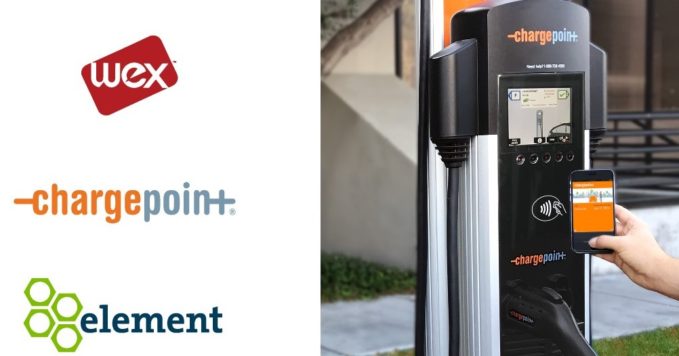
By Ed Pierce, Contributing Editor
January 8, 2022
Fleet Management Weekly had the opportunity to conduct interviews with Avninder Buttar, Vice President, Strategy at Element Fleet Management; Hannah Young, Director, Global Fleet Strategy at WEX; and Rich Mohr, Vice President, Fleet Solutions at ChargePoint to hear their thoughts on the companies’ recently announced collaboration intended to enhance the transition to electric vehicles for fleets.
Since each company involved in this new collaboration has a different perspective of the EV transition, can you give readers the broad view of how things are progressing?
Avninder Buttar of Element highlighted the fact that demand for commercial EVs has exceeded supply in recent years due to limited availability. However, as light-duty pickup trucks and delivery vans begin to arrive and mature in the market, he anticipates an acceleration in the industries and sectors that use those vehicles. Buttar notes the BCG prediction that zero-emission vehicles will account for over 50% of light vehicle sales by 2026. This, in combination with the public commitments to electrification targets made by Element customers in recent years, leads Buttar to expect a sharp increased interest in EV pilots for 2022.
How does this new solution build upon the previous relationship between WEX and ChargePoint?
Hannah Young of WEX discussed WEX’s and ChargePoint’s focus on helping mixed fleets bring in EVs to their current traditional fleets. Because fleets currently face challenges of aggregating network aspects, WEX, ChargePoint, and Element plan to work together to help fleets to easily charge at as many public sites as they can. They also plan to launch different integrated payment tools to minimize the operational burden of consolidating the reporting from electric and non-electric vehicles in the same fleet.
WEX and ChargePoint plan on helping to integrate these tools into Element’s broader offering for customers. This will help clients meet their sustainability and conversion goals by reducing the operational burdens of a fleet going electric.
How does the new collaboration help customers balance charging costs with operational readiness for light to heavy-duty vehicle across depot, on route, and at home charging?
This new collaboration gives customers more fueling locations and broader options of payment methodologies in the wild. They can keep the same integration they’ve been using for their non-electric vehicles while seamlessly integrating more EVs over the years to come.
What changes will Element customers see from this new joint solution? Will the portal change?
Buttar noted that Element clients will be able to charge their EVs through a similar process to using their fuel card. This means that there will be no noticeable change to the Element Xcelerate portal, giving fleet managers access to look at both fuel and public charging data in the same portal. They’ll be able to look at reporting and billing analysis for both the fuel card program and the EV charging program side by side.
How will ChargePoint’s EV design/support services meld with Element’s approach?
Mohr of ChargePoint reiterated the goal of delivering fuel to vehicles in the most efficient way. He assured they would work with engineers and contractors to optimize the electrical cost-effectiveness of their contractor network or procure a contractor if they lack one.
They’ll work with companies on preliminary and final engineering design, permit and construction, and all the way to activation and training. With the ChargePoint model, they’ll work with clients to maximize each of their individual processes to deliver the most effective cost for the project.
Buttar of Element agreed with Mohr on the importance of working with clients to allow for collaboration during every step of the process. He also noted Element’s intention to reduce the complexity of EV integration by supporting the actual physical charging infrastructure roll out for their clients.
What are the concerns for fleet managers as they mix EVs with ICEs?
Buttar talked about the challenge for fleet managers to meet their electrification goals when dealing with varying legislation regarding EVs in different states. He also noted the need to decrease battery costs, which are the bulk of the cost of an EV.
He reiterated the issues with the availability of commercial EVs, discussing the need to help customers ready themselves for the integration of EVs. Other factors he mentioned were the importance of tracking CO2 emissions, reducing maintenance costs and cost per mile, and tracking performance improvement and fuel savings.
What are the key fuel management metrics WEX recommends? How does the introduction of EVs impact the ability to provide a complete accounting of fuel management performance?
Young talked about the importance of capturing detailed metrics like location, frequency, time, cost per unit, and the type of fueling activity that clients use. She iterated that these metrics helped fleet managers design and enforce the most effective spending policies and recognize exceptions or potentially fraudulent activities.
As EVs get introduced into mixed fleets, capturing these metrics is more important than ever to support Fleets’ bottom lines.
How does this collaboration enhance the capability to support mixed fueling fleets?
Mohr stated that ChargePoint prioritizes visibility, access, and control. To that end, they aim to give customers access to how they manage their fleet. They want to enable them to confidently deploy new EVs as easily as they would ICEs.
Will the transition to EV last a decade or more? Do management tools need to be designed for the long term?
 Buttar noted that, although interest in EVs is quickly accelerating, the transition towards EVs is happening gradually. He expected that mixed fleets would be a reality for at least another decade, especially for heavier duty cases.
Buttar noted that, although interest in EVs is quickly accelerating, the transition towards EVs is happening gradually. He expected that mixed fleets would be a reality for at least another decade, especially for heavier duty cases.
He brought up Element’s driver sentiment survey from earlier this year that revealed concerns about EVs regarding range, anxiety, costs, and vehicle availability, and he stated the need to solve for these items early on.
Buttar discussed driver reimbursement and the need to figure out how to consolidate spending, evaluate how much to reimburse drivers, and how to optimize that spend over time. He also mentioned HR policies and the impact that EVs may have on existing HR policies and driver behaviors.
With all of these complexities to work through, he made it clear that tackling these problems early on while gradually making the transition to EVs was imperative for the transition to be a success.
Any fleet management issues or opportunities to speak of?
Buttar of Element again mentioned the need for fleet managers to start building a plan now and designing early pilots in order to make the necessary transition to meet their electrification goals. With the right partners, fleet managers will have the support to cover vehicles, charging, and change management collectively.
The collaboration between Element, WEX, and ChargePoint is acutely focused on helping fleet managers deal with mixed fleets for the next foreseeable future.
WEX’s Young discussed the opportunity to start thinking about mixed fleets in a holistic way rather than managing EV and ICE fleet types separately. She also mentioned the opportunity for more consistent and secure payment environments for the on-route charging ecosystem.
Mohr of ChargePoint pointed out that less than 1% of the total fleet currently deployed in the US is electric. This means that the history and experience that the three companies have is integral in enabling clients to create realistic goals and measure how the technology is performing in relation to meeting those goals.
He urged clients not to over commit or over deploy, but to ensure they have measurable metrics to help guide them as they scale the introduction of EVs into their fleets.






